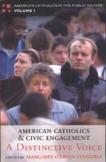Two-Part Harmony
American Catholics and Civic Engagement is the first of two volumes published by American Catholics in the Public Square, a three-year project funded by the Pew Charitable Trusts. Peter Steinfels’ introduction sketches the historical background behind the ongoing struggle of Roman Catholics to define themselves as both loyal Americans and faithful members of the church universal. For much of their experience in the United States, the American part of the equation proved the more elusive. Catholics had repeatedly to defend their participation in American life against skeptics, both inside and outside the church, who doubted that Catholic tradition could ever find harmony with the founding principles of American democracy. Today, articulating the Catholic dimension often presents the more formidable challenge. Catholics who feel very at home in the United States may find it difficult to maintain a distinctively Catholic note in American culture.
Though the vast majority of contemporary Catholics have probably never considered the possibility that love of church could be in conflict with love of nation, Steinfels makes clear that significant elements of the Catholic tradition continue to be at odds with mainstream American thought. Fundamental tensions persist between the Catholic understanding of the common good and the highly individualist ethic prized by so many Americans. At least three developments over the last century have further undermined the already uneasy bridge between Catholicity and Americanness. Since the Progressive era of the early 20th century, liberal reform movements in the United States have been characterized by suspicion of tradition and authority, both of which are hallmarks of Roman Catholicism. Furthermore, the dismantling of the Protestant establishment has given rise to the widespread belief that religious voices should have no influence in American public life (a phenomenon often referred to as the naked public square). Finally, the erosion of the Catholic ethnic subculture and the reforms of the Second Vatican Council have transformed the Catholic world itself, raising new challenges for Catholics seeking to articulate a distinctive voice.
The book approaches the study of Catholics in American public life from four perspectives. Part One contains the most theoretical group of essays, in which such authors as John A. Coleman, S.J., Jane Mansbridge and William Galston explore Catholic social teaching in the American context. Part Two includes noteworthy essays by William Bole and Edward Dolejsi explaining how state Catholic conferences function. These 34 conferences (in 33 states and the District of Columbia) represent Catholic bishops in the public-policy arena, and they are, as Bole notes, one of the Church’s better-kept secrets. Most Catholics barely know state Catholic conferences exist, let alone appreciate the decisive impact they sometimes have.
This section also features an essay by the late Msgr. Philip Murnion on the distinctiveness of the Catholic parish. In contrast to a congregation, which is a self-selecting group, a parish includes all people within a given geographical boundary. Participation in parish life, Murnion argues, is by definition participation in American public life.
People are always more interesting than institutions. I found Part Three to be the most compelling in the book. Politicians, journalists, lawyers, business executives and labor leaders were asked to reflect on how their work has been shaped by their faith. The attorney W. Shepherdson Abell acknowledges the difficulty of this endeavor, noting: I can say something about what I have believed, and I can say something about what I have done. I’m not sure I can connect the dots. Nevertheless, Abell connects the dots quite poignantly, defining his working life according to the credo of one of his Notre Dame law professors: God proposes to deal with me through my client.
Other contributors are even more explicit in envisioning their work as a vocation. For Don Wycliff of The Chicago Tribune, watching the media uncover the murder of a Black Panther leader by Chicago police in 1969 inspired his understanding of journalism as a calling. Paul Moses, another journalist, observes that the best stories in the newspaper are about people struggling to be fully human, which is to be like God.
The essays in Part Four, Catholics in the Voting Booth, are particularly interesting to read during this presidential election year, when candidates are so actively courting the Catholic vote. Whether or not there is any such thing is a fascinating question that is thoughtfully explored by E. J. Dionne, Kate O’Beirne and others. Views on abortion are, of course, central to an understanding of Catholics’ voting patterns. According to David Leege and Paul Mueller, abortion is the only issue that has stimulated increased political activity among Catholics.
While I expected that any exploration of the Catholic distinctive voice would cover the debate over abortion, I was astonished to find that all but a handful of the 23 authors make reference to it, and many explore it at some length. I now have a new appreciation for the extent to which abortion has come to dominate the enormously complex question of Catholic participation in American public life. Contributor Kirk Adams of the A.F.L.-C.I.O. finds this lamentable, criticizing the church hierarchy for exhausting its firepower on reproductive issues for the last 20 years, to the detriment of other social causes such as health care, poverty and immigration.
A minor criticism of the book concerns its style and tone. Though the essays were originally delivered as speeches, they could have been better adapted for a reading rather than a listening audience.
I also yearned for a conclusion that would have both complemented the cogent introduction and tied the many threads together. Perhaps this is planned for the second volume of the series. It is easy to overlook these small annoyances, however, in the face of such a worthwhile and informative book, which should prompt Catholics to consider anew the intersectionsor lack thereofbetween faith and citizenship. Editors Note: This book is the April Catholic Book Club selection.
This article also appeared in print, under the headline “Two-Part Harmony,” in the May 17, 2004, issue.








